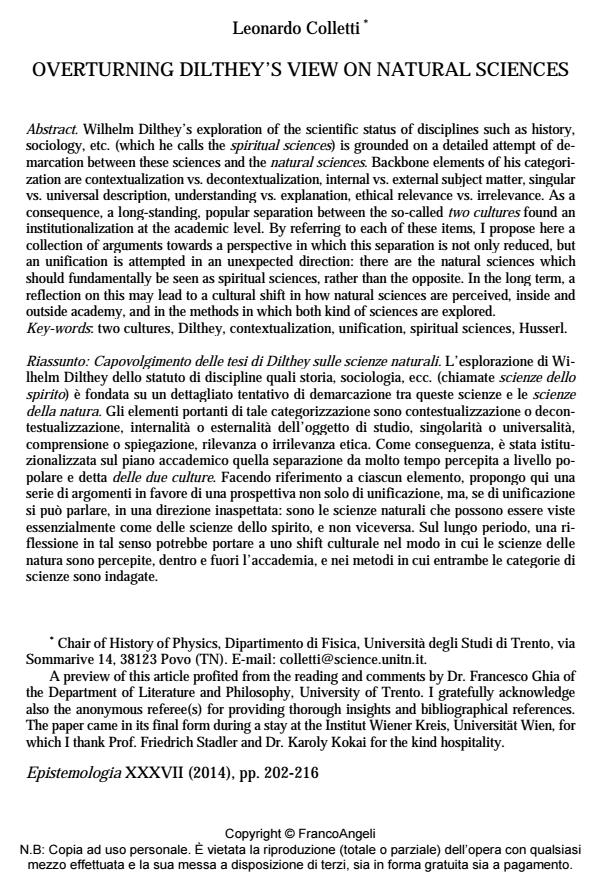Overturning Dilthey’s view on natural sciences
Titolo Rivista EPISTEMOLOGIA
Autori/Curatori Leonardo Colletti
Anno di pubblicazione 2015 Fascicolo 2014/2
Lingua Inglese Numero pagine 15 P. 202-216 Dimensione file 65 KB
DOI 10.3280/EPIS2014-002002
Il DOI è il codice a barre della proprietà intellettuale: per saperne di più
clicca qui
Qui sotto puoi vedere in anteprima la prima pagina di questo articolo.
Se questo articolo ti interessa, lo puoi acquistare (e scaricare in formato pdf) seguendo le facili indicazioni per acquistare il download credit. Acquista Download Credits per scaricare questo Articolo in formato PDF

FrancoAngeli è membro della Publishers International Linking Association, Inc (PILA)associazione indipendente e non profit per facilitare (attraverso i servizi tecnologici implementati da CrossRef.org) l’accesso degli studiosi ai contenuti digitali nelle pubblicazioni professionali e scientifiche
Wilhelm Dilthey’s exploration of the scientific status of disciplines such as history, sociology, etc. (which he calls the spiritual sciences) is grounded on a detailed attempt of demarcation between these sciences and the natural sciences. Backbone elements of his categorization are contextualization vs. decontextualization, internal vs. external subject matter, singular vs. universal description, understanding vs. explanation, ethical relevance vs. irrelevance. As a consequence, a long-standing, popular separation between the so-called two cultures found an institutionalization at the academic level. By referring to each of these items, I propose here a collection of arguments towards a perspective in which this separation is not only reduced, but an unification is attempted in an unexpected direction: there are the natural sciences which should fundamentally be seen as spiritual sciences, rather than the opposite. In the long term, a reflection on this may lead to a cultural shift in how natural sciences are perceived, inside and outside academy, and in the methods in which both kind of sciences are explored.
L’esplorazione di Wilhelm Dilthey dello statuto di discipline quali storia, sociologia, ecc. (chiamate scienze dello spirito) è fondata su un dettagliato tentativo di demarcazione tra queste scienze e le scienze della natura. Gli elementi portanti di tale categorizzazione sono contestualizzazione o decontestualizzazione, internalità o esternalità dell’oggetto di studio, singolarità o universalità, comprensione o spiegazione, rilevanza o irrilevanza etica. Come conseguenza, è stata istituzionalizzata sul piano accademico quella separazione da molto tempo percepita a livello popolare e detta delle due culture. Facendo riferimento a ciascun elemento, propongo qui una serie di argomenti in favore di una prospettiva non solo di unificazione, ma, se di unificazione si può parlare, in una direzione inaspettata: sono le scienze naturali che possono essere viste essenzialmente come delle scienze dello spirito, e non viceversa. Sul lungo periodo, una riflessione in tal senso potrebbe portare a uno shift culturale nel modo in cui le scienze delle natura sono percepite, dentro e fuori l’accademia, e nei metodi in cui entrambe le categorie di scienze sono indagate.
Parole chiave:Two cultures, Dilthey, contextualization, unification, spiritual sciences, Husserl.
- Agazzi E., Di Bernardo G. (eds.) (2010). Relations between Natural Sciences and Human Sciences, Genova, Tilgher.
- Agazzi E., Di Bernardo G. (2010). Introduction. In Agazzi E., Di Bernardo G. (eds.) (2010), Relations between Natural Sciences and Human Sciences, Genova, Tilgher, pp. 5-21.
- Bartley III W.W. (1962). Achilles, the Tortoise, and Explanation in Science and History, The British Journal for the Philosophy of Science, 13(49), pp. 15-33.
- Cassidy D. et al. (2002). Understanding Physics, New York, Springer Verlag.
- Colletti L. (2011). “Schrödinger’s lamentation” and the role of subjectivity in modern physics, Atti Acc. Rov. Agiati, 261(1), serie IX, B, pp. 21-41.
- Dilthey W. (1923-1936). Wilhelm Diltheys Gesammelte Schriften (12 voll.), Leipzig [u.a.], B.G. Teubner Verlag.
- Dilthey W. (1927). Der Aufbau der geschichtlichen Welt in den Geisteswissenschaften. In Dilthey W. (1923-1936), Wilhelm Diltheys Gesammelte Schriften (12 voll.), Leipzig [u.a.], B.G. Teubner Verlag, vol. 7.
- Donagan A. (1964). Historical Explanation: The Popper-Hempel Theory reconsidered, History and Theory, 4(1), pp. 3-26.
- Duhem P.M.M. (1913). Le système du monde: histoire des doctrines cosmologiques de Platon à Copernic, Paris, Hermann.
- Einstein, A., Born H., Born M. (1982). Briefwechsel 1916-1955, Frankfurt, Erbrich.
- Grant E. (1996). The Foundations of Modern Science in the Middle Ages, New York, Cambridge University Press.
- Henry M. (2000). Incarnation, Paris, Edition du Seuil.
- Hodgson P.E. (2001). The Christian Origin of Science, Logos, 4(2), pp. 138-159. 216
- Husserl E. (1936). Die Krisis der europaischen Wissenschaften und die transszendentale Phanomenolgie.
- In Nijhoff M. (ed.), Edmund Husseerl Gesammelte Werke, VI, Haag, Husserliana, 1969.
- Kuhn T.S. (1962). The Structure of Scientific Revolutions, Chicago, University Press.
- Lenk H. (2010). Higher-level interdisciplinarity by methodological scheme-interpretationism. In
- Agazzi, Di Bernardo (eds.) (2010), Relations between Natural Sciences and Human Sciences, Genova, Tilgher, pp. 117-151.
- Michelmore P. (1962). Einstein, Profile of the Man, New York, Dodd.
- Mosterin J. (2010). Human versus Natural: An Untenable Dichotomy. In Agazzi, Di Bernardo
- (eds.) (2010), Relations between Natural Sciences and Human Sciences, Genova, Tilgher, pp. 61-82.
- Poincaré H. (1905). La valeur de la science, Genève, Ed. du Cheval Ailé C. Bourquin, 1946.
- Schrödinger E. (1954). Nature and the Greeks. Shearman Lectures delivered at University College, London on 24, 26, 28, and 31 May 1948, Cambridge, Cambridge University Press.
- Snow C.P. (1959). The Two Cultures and the Scientific Revolution, New York, Cambridge University Press.
- Toulmin S.E. (1990). Cosmopolis: the hidden agenda of modernity, New York, Chicago University Press
Leonardo Colletti, Overturning Dilthey’s view on natural sciences in "EPISTEMOLOGIA" 2/2014, pp 202-216, DOI: 10.3280/EPIS2014-002002